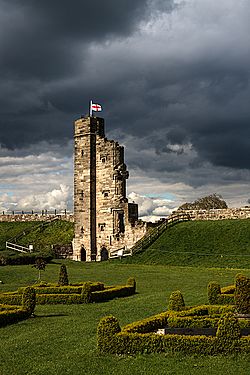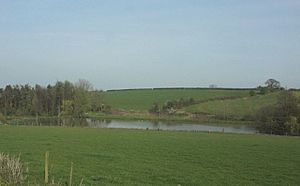Tutbury Castle facts for kids
Quick facts for kids Tutbury Castle |
|
|---|---|
| Staffordshire, England | |

North Tower of Tutbury Castle
|
|
| Lua error in Module:Location_map at line 420: attempt to index field 'wikibase' (a nil value). | |
| Type | Inner and outer bailey walls with great tower |
| Site information | |
| Owner | Duchy of Lancaster |
| Controlled by | English Heritage |
| Open to the public |
Yes |
| Condition | Ruined |
| Site history | |
| Battles/wars | Siege of Tutbury |
Tutbury Castle is a medieval castle in Tutbury, Staffordshire, England. Today, it is mostly in ruins. The castle is owned by the Duchy of Lancaster. It is a very old and important site, protected as a Scheduled Ancient Monument. Many famous people have stayed here, including Eleanor of Aquitaine and Mary, Queen of Scots, who was held prisoner at the castle.
Contents
Castle History: A Journey Through Time
Early Norman Beginnings
Tutbury Castle became an important place for Henry de Ferrers around 1080. It was the main center for a large area called a "wapentake," which was like a county division. Henry de Ferrers and his wife, Bertha, even gave two large estates to Tutbury Priory around this time. It seems Tutbury was connected to a Norman abbey called St Pierre‑sur‑Dives back then.
Medieval Times: Rebuilding and Grandeur
The castle faced tough times in 1264 when Prince Edward almost completely destroyed it. This happened after a rebellion led by Robert de Ferrers, 6th Earl of Derby. In 1269, after another rebellion, the land was given to Edmund Crouchback. Since then, the castle has been part of the Duchy of Lancaster.
By the 1300s, the castle was mostly fixed up. It became more of a home for important people than a strong military fort.
Thomas, the second Earl of Lancaster, who lived from about 1278 to 1322, did a lot to repair the castle. He made it grander and more magnificent than ever before. He chose Tutbury as his main home and lived like a prince. This helped the local area a lot, as he bought many goods from the people living nearby.
The Court of Constance, Duchess of Lancaster
John of Gaunt rebuilt the castle even more before 1370. From 1372 until she passed away in 1394, the castle was the home of Constance, John of Gaunt's wife. Her court was famous for supporting music and art. People said it was like a "modern Windsor" castle because of its grand plans.
Mary, Queen of Scots: A Royal Prisoner
In June 1568, Mary, Queen of Scots arrived at Carlisle Castle. She had fled from Scotland after losing the battle of Langside. The English Privy Council decided to move her further away from the Scottish border. They chose Nottingham Castle, Fotheringhay Castle, or Tutbury as her new lodging.
In January 1569, Mary was moved from Bolton Castle. She traveled through several towns, staying overnight in places like Ripon, Wetherby, Pontefract, Rotherham, Chesterfield, and Wingfield Manor. George Talbot, 6th Earl of Shrewsbury was given detailed instructions on how to keep Mary. He was allowed to house her at Sheffield sometimes, which he preferred.
Tapestries, furniture, and bedding were sent from the Royal Wardrobe at the Tower of London to make Tutbury ready for Mary. However, bad weather caused delays. So, Bess of Hardwick was asked to send her own things from Sheffield. This left the Earl's houses in Sheffield empty, so Mary had to go to Tutbury. She arrived on February 4, 1569.
Mary thought the castle was like a hunting lodge. She said its location on a small hill reminded her of the Bois de Vincennes in France. She complained about the dampness, wet plaster, and old, drafty wooden parts. The British Library has a drawing showing where she stayed at Tutbury.
In March, the Earl of Shrewsbury described Mary sitting with Bess, Countess of Shrewsbury. They were in the countess's room at Tutbury with Lady Livingston and Mary Seton, working on embroidery. Mary moved to Wingfield Manor in April. She was sent back to Tutbury in September with more guards and fewer servants.
In November 1569, after the Catholic Rising of the North, Mary was quickly moved south to Coventry. She stayed in an inn there. Queen Elizabeth ordered her return to Tutbury on Christmas Eve. Mary, who called herself the "pauvre prisonniere" (poor prisoner), was back at Tutbury on January 2, 1570. She was later sent to Chatsworth in May 1570.
In January 1585, Mary returned to Tutbury again, after staying at Wingfield Manor. On her way, she spent a night in Derby at the house of a widowed Mrs Beaumont. Her keepers, Ralph Sadler and John Somer, worked hard to find good hangings for Mary's bedroom. Hangings brought from Lord Paget's nearby houses at Burton and Beaudesert were not good enough.
Mary's bedroom was at the very top of a building, right under the roof. This room was made of wood and had no windows looking out through the castle wall. Its two windows looked into the castle courtyard. To make her room warmer, Mary made a kind of tent over her bed using tapestries.
Mary also had a billiard table at Tutbury. Ralph Sadler sometimes took Mary hunting with his hawks near the River Dove. They would not go farther than three miles from the castle, and a guard of 40 or 50 men on horseback would go with them. Queen Elizabeth did not like this freedom and stopped it.
On April 19, 1585, Mary was placed under the care of Sir Amyas Paulet. He removed Mary's special cloth of estate from the room where he ate. He also stopped Mary's servants from using the wall walk near the gate. Paulet also limited her charity work in the town and took away pistols from her Scottish servants.
In July, Mary was allowed to hunt deer with her greyhound at Stockley Park near Anslow. By August, Mary wanted to move to another house temporarily so her rooms could be cleaned. Mary pointed out that the Earl of Shrewsbury followed this routine. However, Lord Paget's nearby houses and the house of Henry Cavendish at Doveridge were not big enough for all her servants. Paulet thought about changing her lodging or letting the queen use another part of the castle he occupied. This other lodging, where Mary had stayed in 1569, was hard to secure. It had two rooms twenty-four feet above the ground, with windows looking over the ditches towards Tutbury town. These windows and a "house of office" (a latrine) could have been used for escape. On Christmas Eve 1585, she finally moved to Chartley Castle.
The Castle's Destruction
By the late 1500s, the castle began to fall apart. Even so, King James I stayed there several times between 1619 and 1624. In August 1624, he made Sir Henry Rainsford and Sir Edward Vernon knights at the castle.
During the English Civil War, the castle was held by forces loyal to the King (called Royalist forces). They made it stronger for the Crown. In 1643, the Parliament's forces tried to remove the King's soldiers but failed. In April 1646, the King's soldiers gave up after a three-week siege. A surrender agreement was made, signed on April 20, 1646.
However, on July 19, 1647, it was decided that the castle was "untenable" (meaning it couldn't be defended) because of the damage from the siege. Once Parliament controlled the castle, they ordered it to be destroyed. Demolition work happened from 1647 to 1648. Later, in 1780, a decorative building called a "folly" was built on top of the castle's motte (a large mound).
Images for kids










